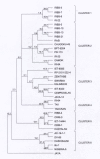Potential of (GATA)n microsatellites from rice for inter- and intra-specific variability studies
- PMID: 11710957
- PMCID: PMC59831
- DOI: 10.1186/1471-2148-1-7
Potential of (GATA)n microsatellites from rice for inter- and intra-specific variability studies
Abstract
Background: The microsatellite, (GATA)n has been frequently used for DNA fingerprinting. However, very few attempts have been made to analyze (GATA)n-containing loci in rice.
Results: Three polymorphic (GATA)n-harboring loci viz. OS1A6, OS1H10 and OS2E7, containing 7-13 repeat motifs were identified from a genomic library of a cultivated rice, Oryza sativa var. Basmati-370 using oligonucleotide probe (GATA)4. When (GATA)n flanking primers were used to screen 26 wilds (representing different genomes of rice), 16 cultivars, 47 Indian elite rice varieties and 37 lines resistant/susceptible to bacterial blight, up to 22 alleles were obtained at an individual locus. Also, interestingly the bacterial blight resistant lines clustered into a separate group from the remaining rice genotypes, when a dendrogram was constructed based on the polymorphism obtained at the three loci. This may be due to the partial homology of the clones OS1H10 and OS2E7 to regions encoding O. longistaminata receptor kinase-like protein and pathogenesis-related protein. The ability of these O. sativa flanking primers to amplify DNA of maize, wheat, barley and oat indicates that these (GATA)n-containing loci are conserved across different cereal genera.
Conclusions: The large allele number obtained reveals the potential of (GATA)n-containing loci as powerful tools to detect simple sequence length polymorphism (SSLP). The (GATA)n-flanking primers were not only useful in distinguishing between closely related genotypes, but could also be used for cross-species amplification and are also conserved across different cereal genera. These loci could also cluster the bacterial blight resistant/susceptible lines into different groups based on the resistance genes present in them.
Figures

Similar articles
-
Development of microsatellite markers and characterization of simple sequence length polymorphism (SSLP) in rice (Oryza sativa L.).Mol Gen Genet. 1996 Oct 16;252(5):597-607. doi: 10.1007/BF02172406. Mol Gen Genet. 1996. PMID: 8914521
-
Genetic analysis of Indian aromatic and quality rice (Oryza sativa L.) germplasm using panels of fluorescently-labeled microsatellite markers.Theor Appl Genet. 2004 Sep;109(5):965-77. doi: 10.1007/s00122-004-1700-2. Theor Appl Genet. 2004. PMID: 15309297
-
Computational and experimental analysis of microsatellites in rice (Oryza sativa L.): frequency, length variation, transposon associations, and genetic marker potential.Genome Res. 2001 Aug;11(8):1441-52. doi: 10.1101/gr.184001. Genome Res. 2001. PMID: 11483586 Free PMC article.
-
Nonrandom distribution and frequencies of genomic and EST-derived microsatellite markers in rice, wheat, and barley.BMC Genomics. 2005 Feb 18;6:23. doi: 10.1186/1471-2164-6-23. BMC Genomics. 2005. PMID: 15720707 Free PMC article.
-
Alien introgression in rice.Plant Mol Biol. 1997 Sep;35(1-2):35-47. Plant Mol Biol. 1997. PMID: 9291958 Review.
Cited by
-
On the origin of Solanum nigrum: can networks help?Mol Biol Rep. 2011 Feb;38(2):1171-85. doi: 10.1007/s11033-010-0215-y. Epub 2010 Jun 24. Mol Biol Rep. 2011. PMID: 20574711
-
A review of microsatellite markers and their applications in rice breeding programs to improve blast disease resistance.Int J Mol Sci. 2013 Nov 14;14(11):22499-528. doi: 10.3390/ijms141122499. Int J Mol Sci. 2013. PMID: 24240810 Free PMC article. Review.
-
Genome-Wide Identification and Characterization of the Sweet Orange (Citrus sinensis) GATA Family Reveals a Role for CsGATA12 as a Regulator of Citrus Bacterial Canker Resistance.Int J Mol Sci. 2024 Mar 2;25(5):2924. doi: 10.3390/ijms25052924. Int J Mol Sci. 2024. PMID: 38474170 Free PMC article.
-
Systemic Identification of Hevea brasiliensis EST-SSR Markers and Primer Screening.J Nucleic Acids. 2017;2017:6590902. doi: 10.1155/2017/6590902. Epub 2017 Jan 23. J Nucleic Acids. 2017. PMID: 28232872 Free PMC article.
-
Development, characterization, and cross-species/genera transferability of SSR markers for rubber tree (Hevea brasiliensis).Plant Cell Rep. 2011 Mar;30(3):335-44. doi: 10.1007/s00299-010-0908-7. Epub 2010 Oct 20. Plant Cell Rep. 2011. PMID: 20960206
References
-
- Epplen JT. On simple repeat GAT/CA sequences in animal genomes: a critical reappraisal. J Hered. 1988;79:409–417. - PubMed
Publication types
MeSH terms
Substances
Associated data
- Actions
- Actions
- Actions
LinkOut - more resources
Full Text Sources

